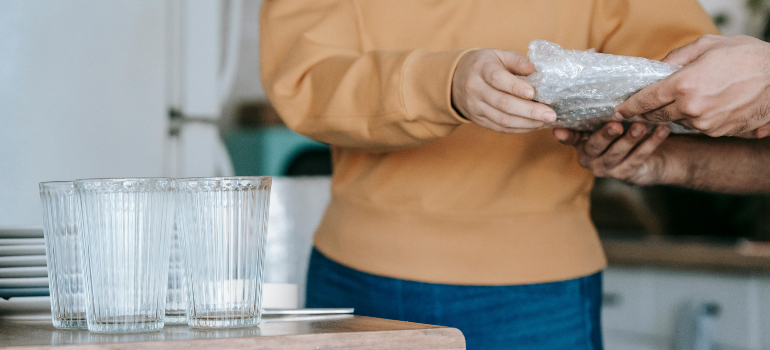Handling Student Belongings and Inventory During Housing Moves
Get a QuoteHandling student belongings and inventory during housing moves demands precision and care. Whether it’s safeguarding cherished mementos or keeping track of essential study materials, the process can be quite challenging. With the right approach, students can navigate these transitions smoothly, ensuring their items are well-organized and secure. In the following sections, Interstate Moving & Storage will cover practical tips and strategies to help make the process as efficient and stress-free as possible.
Preparation Before the Move
Start by creating a moving timeline with key dates and tasks. Include dates for gathering supplies, packing, and the move itself. Break down tasks into manageable chunks, such as packing one room at a time. Develop comprehensive checklists for packing, moving, and unpacking. For example, your packing checklist might include items like textbooks, clothing, and kitchenware. Your moving checklist could cover tasks like changing your address and scheduling utility shut-off and turn-on dates.

Gather all necessary moving supplies. This includes boxes of various sizes, tape, markers, and packing materials like bubble wrap or packing paper. Having everything on hand makes the packing process easier and faster. Don’t forget specialty items like mattress covers or dish pack boxes for extra protection.
Decluttering
Go through your belongings and decide what to keep, donate, or discard. Focus on keeping only essential and valuable items. Ask yourself if you’ve used an item in the last year, and, if not, consider letting it go. Identify local charities or organizations that accept donations. Many charities will even pick up larger items from your home. Research which items each organization accepts to be sure your donations are useful.
Managing Inventory During Housing Moves
Create a detailed inventory list of all your belongings. Use a spreadsheet or a moving app to document each item and its condition. Include details like serial numbers for electronics. Next, take photos of valuable items for reference and insurance purposes if something gets lost or damaged. Make sure each item is clearly visible and include close-ups of any identifying marks or damage. Lastly, use a consistent labeling system for your boxes. Label each box with the room it belongs to and its contents. For example, label a box “Kitchen – Pots and Pans” so you know exactly where it goes and what’s inside.
Packing Strategies for Handling Student Belongings
When packing for a collage move, organize your items by the room they belong to. For instance, pack all your bedroom items together and label the boxes clearly. This helps you set up one room at a time and makes the process smoother. Group similar items, like clothes, books, and electronics, to minimize the risk of losing things and simplify unpacking. Store cords, chargers, and small parts in labeled bags or containers to keep everything in order.
- Toiletries (toothbrush, toothpaste, soap)
- A change of clothes
- Basic kitchen supplies (a couple of plates, utensils, and a coffee maker if needed)
- Important documents (ID, student ID, lease agreement)
Keep this box easily accessible, so you don’t have to search through all your boxes to find what you need on your first day in your new place.
Protecting Fragile Items During Housing Moves
Use bubble wrap or packing paper to protect fragile items. Wrap each item individually and make sure they are secure within the box. Next, ensure adequate padding around delicate items inside boxes. Use towels, blankets, or packing peanuts to fill any gaps. This cushioning absorbs shock and reduces the risk of damage. Lastly, clearly label boxes containing fragile items to alert movers. Use bold, visible writing and add stickers if necessary. Indicate which side should be up to avoid accidental mishandling.

Using Quality Packing Materials for Protecting Your Student Belongings
Use strong boxes that can handle the weight of your items. Avoid using worn or damaged boxes, as they can collapse during the move. Get moving boxes from your local movers in Springfield VA for specific items such as like wardrobe boxes or book boxes. In addition, secure all boxes with heavy-duty packing tape to prevent them from opening during transit. Reinforce the bottom of each box with extra tape for added strength. Tightly seal all seams. More importantly, avoid overpacking boxes to prevent them from breaking. Heavy items like books should be packed in smaller boxes to make them easier to carry. Lighter items can go in larger boxes.
Moving Day Tips for Students
If you hire professional long distance moving companies in Virginia, coordinate with them to ensure your belongings are handled with care. Clearly communicate any specific instructions, such as which items are fragile or need special attention. Make sure they know which boxes contain valuables or delicate items.
Be there during the move to oversee the process and answer any questions that might come up. Your presence ensures everything goes as planned, and you can give directions to keep the move on track.
Use your checklists to make sure all tasks are completed, and nothing is left behind. Double-check each room before leaving, including closets, cabinets, and drawers, to ensure you haven’t overlooked any items.
Unpacking After the Move
Start unpacking with the essential areas like your bedroom, bathroom, and kitchen. Begin by setting up your bed so you have a comfortable place to rest after a tiring day. Tackling one box at a time helps you stay organized and avoid feeling overwhelmed. Focus on completing one room before moving on to the next to keep things manageable.
For students, setting up your study area early on is crucial. Get your desk, chair, and study materials organized right away to ensure you’re prepared for any upcoming assignments or study sessions. By staying organized from the start, you’ll create a functional and comfortable living space that supports your academic needs.
Settling In
Think about how you want to use each room and arrange items accordingly. Add personal touches to make your new place feel like home. For example, you can decorate with photos, artwork, and mementos. These items help you settle in and feel more comfortable in your new environment.
Disposing of Packing Materials
Recycle cardboard boxes and packing materials responsibly by checking with your local recycling program for guidelines. Flatten boxes and separate materials to make recycling easier. Save reusable packing materials, such as bubble wrap, packing paper, and sturdy boxes, for your next move. Store them in a clean, dry place for easy access.
Consider donating any excess supplies to other students who may need them. Local schools, charities, or moving organizations might also accept these materials, ensuring they go to good use. By recycling and reusing packing materials, you contribute to a more sustainable moving process.
Long-Term Organization
Regularly update your inventory list with new items or items that are no longer needed. This helps you stay organized and simplifies future moves. Review and update your list every few months. Keep a digital copy of the inventory list for easy access and backup. Use cloud storage or a moving app to store this information. Make sure your valuable items are covered by insurance. Check your policy to see what is included and consider additional coverage if necessary.

Periodically declutter to maintain an organized living space. Set aside time every few months to go through your belongings. Use student storage solutions to keep items organized and easily accessible. Shelving units, storage bins, and closet organizers help maximize space. Label storage containers to quickly find what you need. Establish a cleaning schedule to keep your space tidy. Regular maintenance prevents clutter from building up.
Efficiently Handling Student Belongings and Inventory During Housing Moves
Handling student belongings and inventory during housing moves can transform the moving experience into a positive one. With effective planning and organization, the process becomes straightforward and stress-free. Proper packing, using durable materials, and keeping a detailed inventory ensure your items are safe and secure. Don’t forget to recycle and donate packing supplies to contribute to a greener environment. By following these tips, you can enjoy a smooth transition and focus on the exciting opportunities your new home and academic journey will bring.
